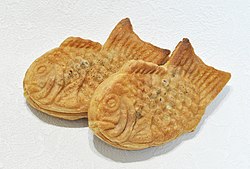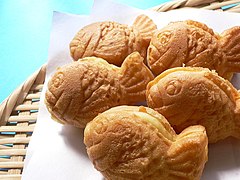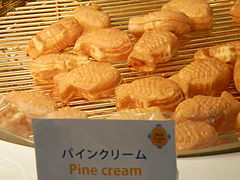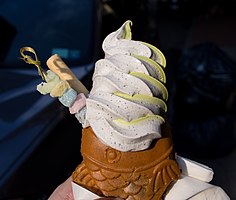| Revision as of 15:41, 9 August 2022 editWhitelove (talk | contribs)32 edits Add Obanyaki← Previous edit | Revision as of 10:34, 11 August 2022 edit undoIneffablebookkeeper (talk | contribs)Extended confirmed users22,747 editsNo edit summaryTags: Mobile edit Mobile web edit Advanced mobile editNext edit → | ||
| Line 8: | Line 8: | ||
| | image_size = 250px | | image_size = 250px | ||
| | image_alt = Two fish-shaped, somewhat flat pastries. | | image_alt = Two fish-shaped, somewhat flat pastries. | ||
| | caption = Two {{ |
| caption = Two {{transliteration|ja|taiyaki}}. | ||
| | alternate_name = | | alternate_name = | ||
| | country = {{JPN}} | | country = {{JPN}} | ||
| Line 23: | Line 23: | ||
| }} | }} | ||
| {{nihongo3|{{lit|baked ]}}|鯛焼き|'''Taiyaki'''}} is a ] ]-shaped ], commonly sold as ]. It imitates the shape of {{nihongo3|]|鯛|tai}}, which it is named after. The most common ] is ] that is made from sweetened ]s. Other common fillings may be ], ], ], or ]. Some shops even sell {{ |
{{nihongo3|{{lit|baked ]}}|鯛焼き|'''Taiyaki'''}} is a ] ]-shaped ], commonly sold as ]. It imitates the shape of {{nihongo3|]|鯛|tai}}, which it is named after. The most common ] is ] that is made from sweetened ]s. Other common fillings may be ], ], ], or ]. Some shops even sell {{transliteration|ja|taiyaki}} with {{transliteration|ja|]}}, ] filling, or a ] inside. Smaller, differently shaped versions called {{nihongo3|{{lit|baked ]}}|金魚焼き|'''kingyoyaki'''}} are also available and often sold in bags of five, ten, or more. | ||
| {{ |
{{transliteration|ja|Taiyaki}} are similar to {{transliteration|ja|]}}, which are thick round cakes also filled with sweet adzuki bean paste or custard. | ||
| ==Ingredients== | ==Ingredients== | ||
Revision as of 10:34, 11 August 2022
Japanese fish-shaped cakeNot to be confused with Teriyaki or Takoyaki.
| This article does not cite any sources. Please help improve this article by adding citations to reliable sources. Unsourced material may be challenged and removed. Find sources: "Taiyaki" – news · newspapers · books · scholar · JSTOR (January 2022) (Learn how and when to remove this message) |
 Two taiyaki. Two taiyaki. | |
| Course | Snack |
|---|---|
| Place of origin | |
| Region or state | Japanese-speaking areas |
| Main ingredients | Batter, sweetened adzuki beans |
Taiyaki (鯛焼き, lit. 'baked sea bream') is a Japanese fish-shaped cake, commonly sold as street food. It imitates the shape of tai (鯛, red sea bream), which it is named after. The most common filling is red bean paste that is made from sweetened adzuki beans. Other common fillings may be custard, chocolate, cheese, or sweet potato. Some shops even sell taiyaki with okonomiyaki, gyoza filling, or a sausage inside. Smaller, differently shaped versions called kingyoyaki (金魚焼き, lit. 'baked goldfish') are also available and often sold in bags of five, ten, or more.
Taiyaki are similar to imagawayaki, which are thick round cakes also filled with sweet adzuki bean paste or custard.
Ingredients

Taiyaki is made using regular pancake or waffle batter. The batter is poured into a fish-shaped mold for each side. The filling is then put on one side and the mold is closed. It is then cooked on both sides until golden brown.
History

Taiyaki was first sold in Japan in 1909. It is essentially a reshaped form of imagawayaki, an already popular snack made by wrapping bean paste in flour skin.
Seijirō Kobe, founder of the store Naniwaya Sōhonten (浪花家総本店), was having trouble selling his imagawayaki, so he decided to bake the cakes into fish shapes resembling tai, or red sea bream. Tai are considered a symbol of luck and fortune in Japan, and were an expensive fish only affordable by the higher classes or on special occasions. Masamori Kobe, the fourth owner of the store, stated that Seijirō wanted to give the ordinary people a taste of the expensive fish at low prices.
Since its creation, taiyaki has evolved into many variations, with different ingredients being used for filling and batter, as well as variations in shapes and sizes.
Taiyaki was introduced to Korea during the Japanese colonial period, where it is known as bungeo-ppang.
During the postwar period, taiyaki spread to other Asian countries, as well as to the United States.
Gallery
-
Taiyaki being made
-
 Standard taiyaki
Standard taiyaki
-
 Cut taiyaki, showing the adzuki bean filling
Cut taiyaki, showing the adzuki bean filling
-
 Taiyaki with sweet potato filling
Taiyaki with sweet potato filling
-
 Square taiyaki with uncut edges, being sold in Ueno
Square taiyaki with uncut edges, being sold in Ueno
-
 Round taiyaki in the form of coiled fishes, being sold in Gunma
Round taiyaki in the form of coiled fishes, being sold in Gunma
-
 Mini taiyaki
Mini taiyaki
-
 Mini taiyaki with pineapple filling, being sold in Hawaii
Mini taiyaki with pineapple filling, being sold in Hawaii
-
 Train-shaped taiyaki, being sold outside Narimasu Station
Train-shaped taiyaki, being sold outside Narimasu Station
-
 Taiyaki used as an ice cream holder, being sold in Taipei
Taiyaki used as an ice cream holder, being sold in Taipei
-
 Taiyaki with red bean and matcha-swirled ice cream, mochi, and a wafer cookie
Taiyaki with red bean and matcha-swirled ice cream, mochi, and a wafer cookie
-
 Taiyaki filled with matcha ice cream
Taiyaki filled with matcha ice cream
See also
- Bungeo-ppang, a similar Korean snack
- "Oyoge! Taiyaki-kun", a song about taiyaki
- Wagashi, Japanese confectionery
References
| Japanese food and drink | |||||||||
|---|---|---|---|---|---|---|---|---|---|
| Shushoku |
| ||||||||
| Okazu | |||||||||
| Soup (Shirumono) | |||||||||
| Set menu | |||||||||
| Beverages |
| ||||||||
| Snacks / desserts/ Wagashi | |||||||||
| Fruits | |||||||||
| Ingredients / condiments | |||||||||
| Utensils | |||||||||
| Lists | |||||||||
| Related | |||||||||